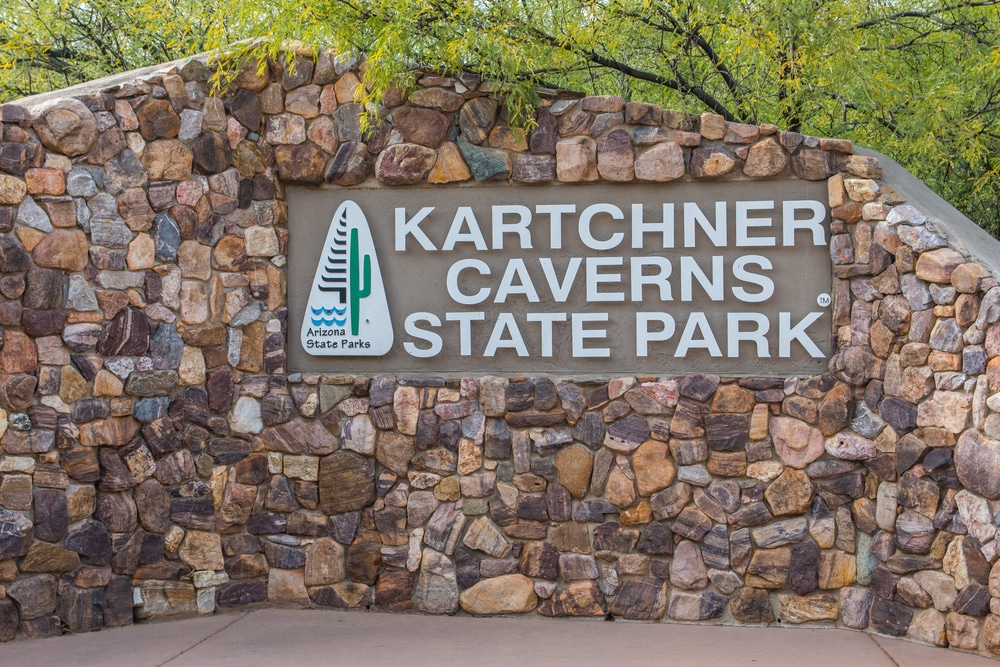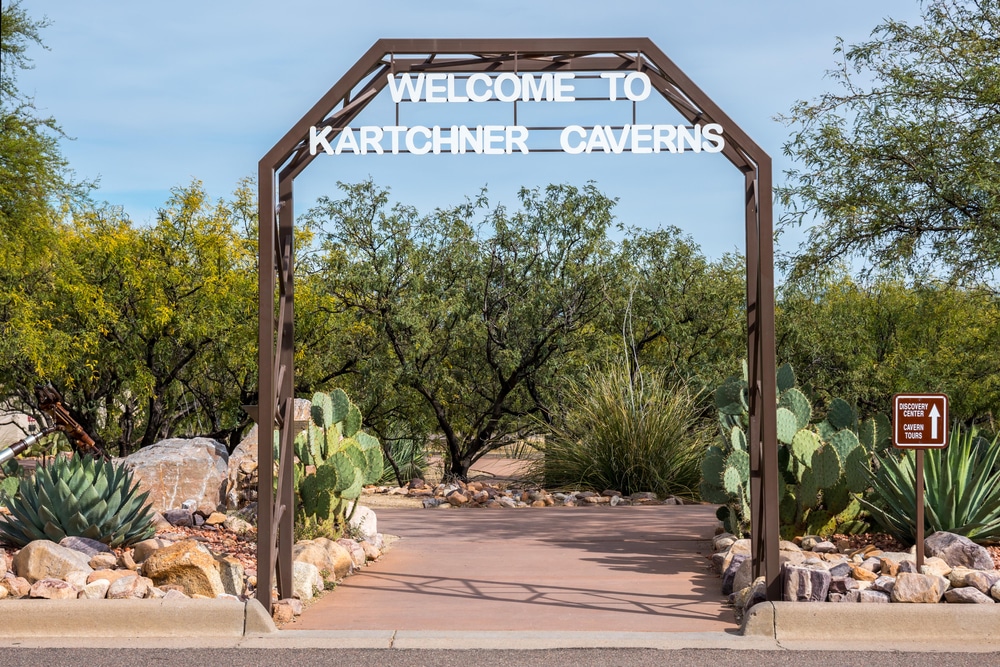Tucked away at the eastern base of the Whetstone Mountains in southeastern Arizona lies one of the state’s most remarkable natural treasures—Kartchner Caverns State Park. This extraordinary underground wonderland remained a closely guarded secret for nearly 14 years after its discovery in 1974 by amateur cavers Gary Tenen and Randy Tufts. The two explorers stumbled upon a narrow crack in a sinkhole, following warm, moist air to discover what would prove to be over 2.4 miles of pristine cave passages.
What makes Kartchner Caverns truly special is its status as a “living” cave, where water continues to seep through limestone, allowing its spectacular formations to grow and evolve even today. Located just 9 miles south of Benson, Arizona, the park officially opened to the public in 1999 after the state implemented extensive conservation measures to protect its delicate ecosystem. Prior to its grand opening, Arizona invested $28 million in sophisticated preservation technologies, including air-lock doors and misting systems that maintain the cave’s natural humidity and atmosphere.

Kartchner Caverns stands as a testament to responsible conservation. Rather than keeping their discovery to themselves, Tenen and Tufts approached the landowners, the Kartchner family, in 1978 to ensure the cave’s long-term protection. After careful consideration and collaboration with Arizona State Parks, the cave was finally revealed to the public in 1988 when the land was sold to the state for development as a park and show cavern. Today, the park not only showcases the underground marvels but also offers visitors a comprehensive experience with its Discovery Center, campground facilities, hiking trails, and educational programs, all designed to highlight the significance of this geological masterpiece in Arizona’s diverse park system.

Kartchner Caverns offers guided tours of a spectacular living limestone cave system discovered in 1974 and kept secret for 14 years to protect its pristine condition. The Rotunda/Throne Room Tour showcases the cavern’s massive formations including the 58-foot tall Kubla Khan column, while the Big Room Tour (seasonal from October-April) features a remarkable concentration of formations and important bat habitat. These ranger-led experiences include educational presentations about the cave’s discovery, formation processes, and the extraordinary efforts taken to preserve its delicate ecosystem.

The state-of-the-art Discovery Center features interactive exhibits explaining cave formation, the specialized ecosystem within Kartchner Caverns, and the technological innovations developed to preserve the cave during its development. Displays include a replica cave room where visitors can touch formations, scientific equipment used in cave research, and presentations on the diverse wildlife that inhabits both the caverns and surrounding landscape.

The park maintains several hiking trails that showcase the unique desert environment surrounding the caverns. The Foothills Loop Trail offers a moderately challenging 2.5-mile route through limestone hills with panoramic views of the Whetstone Mountains and San Pedro Valley. The shorter Garden Bridge Trail provides an accessible path through desert vegetation with interpretive signage highlighting ecological adaptations to the arid environment.

The diverse landscapes within Kartchner Caverns State Park create exceptional photography opportunities. Unique geological formations outside the caverns, seasonal wildflowers, desert wildlife, and dramatic mountain vistas provide compelling subjects throughout the year. Early morning and late afternoon light particularly enhances the textures and colors of the desert landscape.

The park’s location in the ecologically rich San Pedro River Valley makes it a hotspot for bird diversity. Over 170 species have been documented within park boundaries, with notable sightings including vermilion flycatchers, varied buntings, and several hummingbird species. The riparian areas are particularly productive for birding, while the visitor center provides bird checklists and spotting scopes for visitor use.

Kartchner Caverns offers 62 developed campsites accommodating tents and RVs, with both electric/water hookups and more primitive options available. Each site includes a picnic table, fire ring, and shade ramada. The campground features modern restrooms with hot showers, and its higher elevation provides cooler temperatures than surrounding areas during summer months. The Whetstone Mountains create a scenic backdrop for this comfortable desert camping experience.
Designated as an International Dark Sky Park, Kartchner Caverns offers exceptional stargazing opportunities with minimal light pollution. The park occasionally hosts astronomy programs with telescopes and guided constellation tours. The clear, dry air and higher elevation create ideal conditions for observing celestial objects, from familiar constellations to distant galaxies normally obscured by urban lighting.

| Detail | Information |
|---|---|
| Location | Benson, Arizona (about 9 miles south of I-10) |
| Discovered | 1974 by Gary Tenen and Randy Tufts |
| Opened to Public | November 1999 |
| Size | 2.4 miles of passages |
| Cave Type | Living limestone cave system |
| Notable Formations | Kubla Khan (58-foot tall column), Throne Room, Big Room, Strawberry Room |
| Special Features | One of the world’s longest soda straw stalactites (21 feet 2 inches) |
| Wildlife | Home to a significant bat nursery colony (primarily in summer) |
| Tours Available | Rotunda/Throne Room Tour, Big Room Tour (seasonal) |
| Reservation | Advance reservations recommended |
| Hours | Varies by season; cave tours run throughout the day |
| Amenities | Discovery Center, hiking trails, campground, gift shop, café |
| Conservation | Highly protected environment with airlock entrances and climate controls |
| Temperature | Constant 70°F inside caves with 99% humidity |
| Accessibility | Wheelchair accessible tours available |
Kartchner Caverns represents an exceptional example of limestone cave formation in the American Southwest. The caverns were formed over hundreds of thousands of years as rainwater, slightly acidic from absorbing carbon dioxide from the air and soil, penetrated cracks in the limestone hills of the Whetstone Mountains. This slow dissolution process carved out extensive passages within the limestone. As groundwater levels dropped, these passages became air-filled rooms, setting the stage for the development of the remarkable formations visitors witness today.
The park encompasses most of a down-dropped block of Paleozoic rocks on the eastern flank of the Whetstone Mountains. The caverns themselves contain approximately 2.4 miles (3.9 km) of passages, though only about 40% of the cave system is open to the public. The remainder is preserved in its natural state for scientific study and conservation. The accessible portions include several named areas such as the Rotunda Room, Throne Room, Strawberry Room, Cul-de-sac Passage, and Mud Flats, each offering unique formation characteristics.
One of the most impressive features is “Kubla Khan,” a towering column formation that stands as the tallest in Arizona at 58 feet. Another remarkable formation is the “Soda Straw” stalactite, measuring more than 21 feet long—an exceptional length for such a delicate structure that continues to grow today. The cave is also home to a wide variety of speleothems (cave formations) including stalactites, stalagmites, helictites, cave bacon, and other calcite formations that have been growing for over 50,000 years.
The environment within the caverns maintains a constant temperature of approximately 70°F (21°C) year-round with nearly 99% humidity, creating the perfect conditions for the continued growth of these spectacular formations. This high humidity is carefully preserved through a sophisticated system of airlocks and misting machines installed during the cave’s development as a public attraction. Outside the caverns, the surrounding landscape features the characteristic Sonoran and Chihuahuan Desert terrain, with the San Pedro River valley visible from higher elevations within the park.
The diverse ecosystems surrounding Kartchner Caverns State Park create a rich tapestry of plant and animal life that thrives in the meeting point of several distinct habitats. The park’s location at the convergence of the Sonoran and Chihuahuan Desert regions, combined with the proximity to the Whetstone Mountains and the San Pedro River, creates a unique environment that supports an impressive variety of species adapted to this transition zone.
The vegetation at Kartchner Caverns reflects its desert setting while showcasing the unique characteristics of a Sky Island ecosystem. Lower elevations feature typical Chihuahuan semi-desert grassland that has been gradually invaded by mesquite. As visitors ascend the trails into the Whetstone Mountains, the landscape transitions to open oak-juniper woodland at higher elevations. Throughout the park, visitors will encounter iconic desert plants including various cacti species, ocotillo, creosote bushes, and seasonal wildflowers that create vibrant displays after rainfall. The park also maintains a Hummingbird Garden, which attracts numerous species of these tiny, colorful birds, especially during migration seasons.
Wildlife viewing opportunities abound at Kartchner Caverns, with the park serving as home to a diverse array of desert creatures. Perhaps most famous are the approximately 2,000 Mexican free-tailed bats (Myotis velifer) that roost in the cave’s Big Room during late spring and summer. These remarkable mammals return to the caverns around the end of April, with females giving birth to a single pup in late June. During their summer residence, the colony consumes an estimated half-ton of insects, including moths, flying ants, beetles, mosquitoes, and termites, serving as natural pest control for the region. To protect this critical bat nursery, the Big Room is closed to public tours from mid-April to mid-October.
Beyond the bats, the park hosts numerous other wildlife species. Hikers might spot:
The park’s eBird sightings list serves as a valuable resource for identifying the many birds that can be observed. Larger mammals including mountain lions range throughout the Whetstone Mountains, while coyotes, gray foxes, skunks, raccoons, coatimundi, and ringtail cats represent some of the other mammal species that inhabit the area.
Inside the caves themselves, specially adapted insects have evolved to survive in the dark, humid environment. These unique cave-dwelling species form an important part of the cavern’s delicate ecosystem and are featured in displays at the Discovery Center, highlighting the remarkable adaptations that allow life to flourish even in such specialized environments.
The park also houses rare paleontological treasures, with the Discovery Center displaying original 86,000-year-old sloth bones and a 36,000-year-old horse skull, along with smaller bones from bear, extinct antelope, bobcat, ringtail cat, and rabbit—all discovered within the caverns.
Kartchner Caverns State Park offers visitors a diverse array of recreational activities centered around its spectacular cave system and surrounding natural landscapes. While the cavern tours undoubtedly serve as the park’s main attraction, numerous other outdoor pursuits await those looking to experience the full range of what this remarkable destination has to offer.
The cave tours provide the most memorable and unique experience at Kartchner Caverns. Several tour options allow visitors to explore different sections of the cave system:
Rotunda/Throne Room Tour: Follows the original trail discovered by Tenen and Tufts, covering a half-mile journey that takes approximately 1.5 hours (with 50 minutes spent underground). Highlights include the majestic Kubla Khan, Arizona’s tallest column formation at 58 feet, and the 21-foot-long “soda straw” stalactite that continues to grow.
Big Room Tour: Available from October through April, this tour showcases strange and colorful formations along with information about the cave’s living and ancient fauna.
Helmet & Headlamp Tour: Offers a more authentic caving experience, allowing guests to explore the caverns as the discoverers did in 1974, using only the light provided by headlamps.
Photo Tour: The monthly Photo Tour is the only occasion when visitors are permitted to bring cameras into the caverns.
For those who prefer above-ground activities, the park features several hiking trails that showcase the beautiful desert landscape surrounding the caves:
Foothills Loop Trail: Offers a 2.5-mile moderate hike through Chihuahuan semi-desert grassland, providing excellent wildlife viewing opportunities.
Guindani Trail (#398): A 4.2-mile path on the east flank of the Whetstone Mountains that ranges from easy to strenuous sections as it climbs from 4,750 feet at the trailhead to over 5,620 feet at its highest point. The trail traverses through changing vegetation zones, from mesquite grasslands to oak-juniper woodland. From higher elevations, hikers are rewarded with panoramic views of the San Pedro Valley and surrounding sky island mountain ranges.
Wildlife viewing represents another popular activity at Kartchner Caverns. The park’s diverse habitats support an impressive variety of desert creatures. Birdwatchers will find the park particularly rewarding, with numerous species visible throughout the year and especially during migration seasons. The Hummingbird Garden serves as an excellent spot to observe these fascinating birds. The park also hosts seasonal bat watching programs, where guests can observe and learn about the thousands of Mexican free-tailed bats that roost in the caverns during summer months.
Kartchner Caverns has been designated as a “Dark Sky Park” by the International Dark Sky Association, making stargazing another premier activity. The park’s commitment to minimizing light pollution creates ideal conditions for amateur astronomers and casual night sky observers alike. On clear nights, the stars shine with remarkable brilliance, and visitors can often spot planets, meteor showers, and even the Milky Way with stunning clarity.
For fishing enthusiasts, while the park itself doesn’t have fishing facilities, nearby Patagonia Lake State Park (about an hour’s drive away) offers excellent fishing opportunities. The lake is stocked with rainbow trout during winter months and naturally supports populations of bass, catfish, and other species year-round.
Kartchner Caverns State Park offers excellent camping and accommodation options for visitors wishing to extend their stay and fully immerse themselves in the natural beauty of this unique destination. The park’s well-maintained facilities and strategic location make it an ideal base for exploring both the caverns and the surrounding attractions of southeastern Arizona.
The campground at Kartchner Caverns features 60 spacious sites nestled at the base of the Whetstone Mountains, offering spectacular views of the surrounding landscape. Each campsite comes well-equipped with modern amenities, including:
The back-in sites provide 110-volt AC with a 30-amp RV connection and a 20-amp receptacle, while pull-through sites offer 220-volt 50-amp AC and 110-volt 30-amp AC RV connections with a 20-amp GFI receptacle. Site lengths vary from 35 feet for the shortest back-in sites to 60 feet for the pull-through options, accommodating a range of RV sizes and camping setups. All sites feature single width with ample side areas for pull-out units.
For visitors seeking a more comfortable accommodation option while still enjoying the outdoor experience, Kartchner Caverns offers four west-facing cabins that provide stunning mountain views. Each cabin can sleep up to six people, with one queen-sized bed and two sets of bunk beds. The cabins are equipped with:
It’s important to note that these are “dry” cabins without plumbing facilities, though clean restrooms and showers are conveniently located very close by. Cabin guests must supply their own linens, pillows, and towels.
The comfort and cleanliness of the facilities at Kartchner Caverns regularly receive praise from visitors. The campground features well-maintained restroom and shower facilities located on the upper west end of each camping loop. These buildings also include dishwashing sinks on the rear east side and bottled water vending machines for convenience. A dump station is available for RV campers. The entire campground is meticulously maintained, with sites cleaned and raked between stays.
Camping fees at Kartchner Caverns are $50 per night, with this fee covering the use of shower/restroom facilities, water, electrical hookups, and the dump station. Campsite reservations can be made online through the Arizona State Parks website or by calling the reservation desk at 1-877-MY-PARKS (697-2757). For campers’ convenience, the entrance fee to the park is waived with campsite reservations. The maximum stay allowed is 14 days, allowing ample time to explore the area thoroughly.
For those who prefer not to camp but still want to visit the park, nearby accommodations are available in Benson, just 9 miles north of the park. Benson offers several hotels and motels catering to different budgets and preferences. Additionally, Tucson is approximately an hour’s drive from the park and provides a wide range of accommodation options from budget to luxury, along with numerous dining and entertainment choices for visitors who prefer urban amenities after a day exploring the caverns.
Planning a successful visit to Kartchner Caverns State Park requires some advance preparation to ensure the best possible experience at this unique destination. From timing considerations to practical logistics, here’s comprehensive information to help visitors make the most of their trip to this remarkable underground wonder.
Kartchner Caverns State Park operates year-round, with the Discovery Center and park grounds open from 8:00 a.m. to 5:00 p.m. daily. However, there are some seasonal variations that visitors should note:
Entrance fees for Kartchner Caverns State Park are structured as follows:
These fees cover access to the park grounds, hiking trails, and the Discovery Center. Cave tours require additional tickets that should be reserved well in advance, especially during peak seasons. The park offers several tour options at different price points. The entrance fee is waived for visitors who have reserved cave tours or campsites.
While the caverns maintain a constant temperature of around 70°F (21°C) and 99% humidity year-round, exterior temperatures can vary dramatically:
Accessibility is a priority at Kartchner Caverns, with the park designed to accommodate visitors with various mobility needs. The Discovery Center and cave tours are ADA-accessible, with paved, relatively flat trails inside the caverns. However, some passages may present challenges for persons with severe mobility issues, respiratory concerns, or claustrophobia due to dim lighting and occasionally narrow or enclosed areas. For specific accessibility needs, contacting the park in advance is recommended.
Visitors should be aware of several important park policies:
Cell service can be limited within the park, though Wi-Fi is available in certain areas, particularly near the Discovery Center. For reliable communication, it’s advisable to download maps and important information before arriving. Visitors planning to explore the hiking trails should bring plenty of water, sun protection, and appropriate footwear, regardless of the season. The desert environment can be deceptively harsh, with limited shade available on most trails.
Kartchner Caverns State Park offers visitors comprehensive facilities and amenities designed to enhance their experience while exploring this natural wonder. The thoughtful development of the park ensures that guests have access to modern conveniences while still preserving the pristine nature of the caverns and surrounding landscape.
The Discovery Center serves as the focal point for visitors upon arrival and provides an informative introduction to the park’s natural and cultural history. This modern facility houses a variety of educational exhibits that delve into:
Interactive displays include:
The Discovery Center also houses remarkable paleontological specimens discovered within the caverns, including 86,000-year-old sloth bones and a 36,000-year-old horse skull, along with smaller bones from various extinct and extant species.
Before embarking on cave tours, visitors can view a comprehensive 15-minute orientation film that chronicles the discovery of the caverns and the 25-year journey to their development as a public attraction. This introduction provides valuable context for understanding the significance of what visitors will see underground. Cave tours depart from the Discovery Center, with all tours led by knowledgeable guides who provide fascinating insights into the formation, discovery, and ongoing conservation of the caverns. For visitors’ convenience, lockers are available to store personal belongings that cannot be taken into the caves.
The park features clean, modern restroom facilities located throughout the grounds, including at the Discovery Center and within the campground areas. Shower facilities are available for campers, along with dishwashing sinks located at the restroom buildings in the campground. The campsites themselves are well-appointed with picnic tables, fire rings, water hookups, and electrical connections, providing a comfortable base for exploring the park.
For those looking to bring home a memento of their visit, the Discovery Center houses a well-stocked gift shop offering a variety of Kartchner Caverns souvenirs for adults and children. The merchandise includes:
Picnic areas are strategically placed throughout the park, offering visitors pleasant spots to enjoy meals amid the natural beauty of the Sonoran Desert landscape. These areas typically include tables and, in some cases, ramadas providing welcome shade during warmer months. Water fountains and bottled water vending machines are available in key locations, helping visitors stay hydrated in the arid environment.
While Kartchner Caverns does not have dedicated playground facilities, the natural setting provides ample opportunities for children to explore and learn about desert ecosystems. Educational programs specifically designed for younger visitors are offered periodically, particularly during school holidays and summer months.
The park’s commitment to accessibility is evident throughout its facilities, with wheelchair-accessible pathways, restrooms, and viewing areas. The cave tours themselves feature paved trails and appropriate lighting, though some inclines within the caverns may require assistance for wheelchair users.
Kartchner Caverns State Park serves as an excellent starting point for exploring the diverse attractions of southeastern Arizona. The region offers a wealth of natural, cultural, and historical sites that complement a visit to the caverns and provide opportunities to extend your Arizona adventure beyond the park boundaries.
Just 9 miles north of Kartchner Caverns lies the town of Benson, a convenient hub for travelers with its selection of restaurants, accommodations, and services. Originally established as a railroad town in 1880, Benson now serves as a gateway to the natural wonders of Cochise County. Visitors can explore:
Approximately 30 minutes southeast of Kartchner Caverns is the legendary town of Tombstone, known as “The Town Too Tough to Die.” This iconic Wild West settlement allows visitors to step back in time to the 1880s frontier era. Activities include:
About 45 minutes south of the park lies the distinctive mining town of Bisbee, nestled in the Mule Mountains. Once one of the richest mineral sites in the world, Bisbee has transformed into a thriving arts community while preserving its mining heritage. Visitors can:
Nature lovers will appreciate the nearby Sierra Vista area, about 40 minutes southwest of Kartchner Caverns. This region is renowned for its exceptional biodiversity, particularly for birdwatching:
For those willing to venture a bit farther, Saguaro National Park and the vibrant city of Tucson lie about an hour northwest of Kartchner Caverns. Tucson offers all the amenities of a major metropolitan area along with distinctive attractions such as:
Saguaro National Park showcases the iconic giant cacti in their natural habitat, with extensive trail systems for hiking and exploration.
Water recreation enthusiasts can head to Patagonia Lake State Park, about an hour south of Kartchner Caverns. This 265-acre man-made lake offers opportunities for swimming, fishing, boating, and camping in a scenic setting. The adjacent Sonoita Creek State Natural Area features approximately 20 miles of trails and the possibility of spotting the rare Elegant Trogon among numerous other bird species.
The story of Kartchner Caverns represents one of the most remarkable conservation success stories in American natural resource management. From its very discovery, protection and preservation have been central to the cavern’s development, establishing a model for responsible stewardship of delicate underground ecosystems.
When cavers Gary Tenen and Randy Tufts discovered the cave in 1974, they made an immediate commitment to its protection. Rather than sharing their find with fellow cavers, they kept the cave’s existence secret for 14 years while carefully exploring its passages and documenting its features. This extraordinary patience and foresight stemmed from their firsthand knowledge of how easily cave formations can be damaged or destroyed by improper visitation. In 1978, they approached the landowners, the Kartchner family, and together they began a decade-long process of determining how best to protect this underground treasure.
The decision to develop Kartchner as a state park represented a groundbreaking approach to cave conservation. Prior to its grand opening in 1999, Arizona State Parks invested $28 million in sophisticated protective measures designed to minimize human impact while allowing controlled public access. These include:
The park continuously monitors environmental conditions inside the caverns, including temperature, humidity, and carbon dioxide levels, making adjustments as needed to preserve the delicate balance that allows the cave formations to continue growing.
Seasonal closures demonstrate the park’s commitment to wildlife conservation. From mid-April to mid-October, the Big Room is closed to public tours to protect the important nursery colony of approximately 2,000 Mexican free-tailed bats that roost there during summer months. These bats play a crucial ecological role, consuming approximately half a ton of insects during their residence period. Additionally, the park implements strict White Nose Syndrome protocols to protect the bat population from this devastating fungal disease that has decimated bat colonies across North America.
Visitor education forms another pillar of the conservation strategy at Kartchner Caverns. The Discovery Center features exhibits specifically addressing the challenges facing show caves and the importance of preservation. Tour guides emphasize conservation messages throughout cave visits, helping visitors understand why seemingly small actions—from touching formations to bringing outside contaminants into the cave—can cause significant damage. The park also hosts regular educational programs that highlight the scientific value of the caverns and the ongoing research that continues to reveal new insights about cave formation, mineralogy, and paleontology.
For visitors interested in taking a more active role in conservation efforts, Kartchner Caverns offers various volunteer opportunities:
The Leave No Trace principles are strongly emphasized throughout the park, encouraging visitors to minimize their impact both inside the caverns and on the surrounding desert landscape. These principles include proper waste disposal, staying on designated trails, respecting wildlife, and leaving natural features undisturbed. By practicing these responsible outdoor ethics, visitors help ensure that Kartchner Caverns State Park will continue to inspire and educate future generations.
Most tours last between 1.5 to 1.75 hours, with approximately 50-60 minutes spent underground. The walking distance is about half a mile on paved trails with some moderate inclines. The tours are designed to be accessible but do require some walking ability.
Regular photography is not permitted inside the caverns to protect the delicate environment. However, the park offers special Photo Tours once monthly where photography is allowed under controlled conditions.
Yes, the Discovery Center and cave tours are ADA-accessible with paved trails. Some assistance may be needed on certain inclines within the cave. Contact the park directly for specific accommodation information.
Pets are allowed in the campground and outdoor areas of the park but must be leashed. Pets are not permitted on cave tours or left unattended in vehicles. Only service animals meeting ADA standards are permitted in buildings.
Spring (March-April) and fall (October-November) offer the most pleasant outdoor temperatures. Summer can be very hot for hiking but is fine for cave tours. Winter provides mild daytime temperatures ideal for outdoor activities.
For weekend visits or holiday periods, 1-2 months in advance is recommended. Weekday visits may be available with shorter notice, but advance reservations are still advised.
Children of all ages are welcome on the Rotunda/Throne Room Tour. The Big Room Tour is not available for children under 7 years of age, and the Helmet & Headlamp Tour is not available for children under 10.
The park has vending machines but no restaurant. Visitors are encouraged to bring picnic meals or visit restaurants in nearby Benson.
The park is approximately 55 miles (about 1 hour) southeast of Tucson and 175 miles (about 2.5-3 hours) southeast of Phoenix.
The Big Room serves as a nursery roost for a colony of Mexican free-tailed bats from approximately mid-April to mid-October and is closed to protect these important mammals during their breeding season.
We use cookies to improve your experience on our site. By using our site, you consent to cookies.
Manage your cookie preferences below:
Essential cookies enable basic functions and are necessary for the proper function of the website.